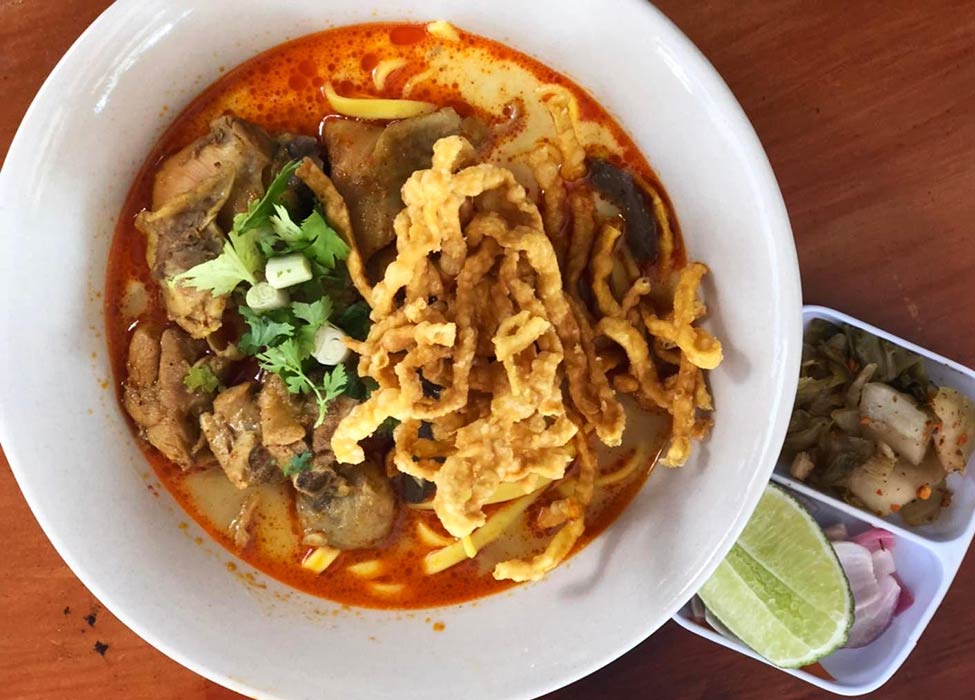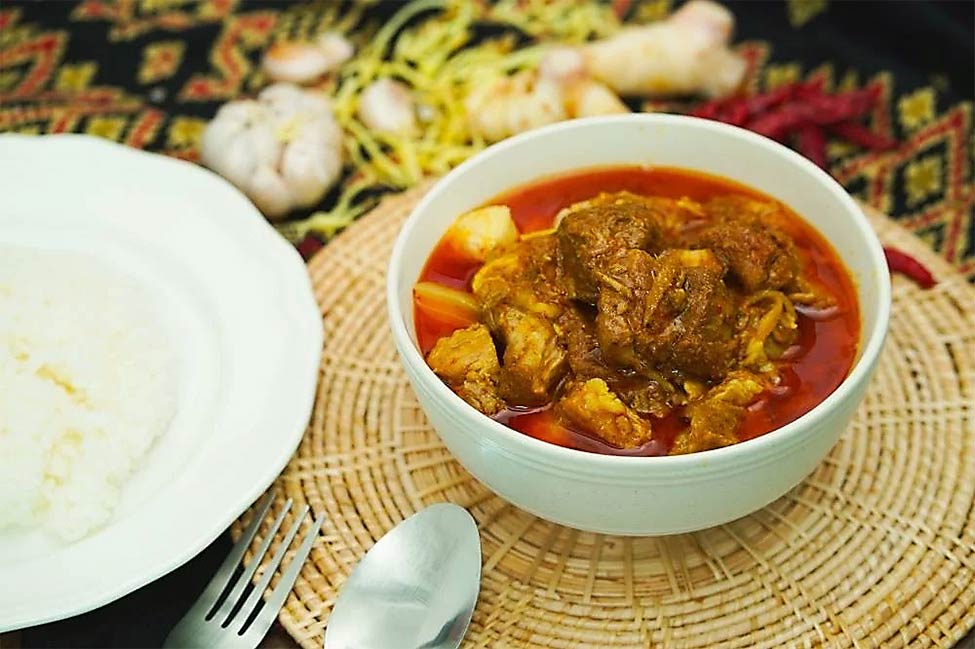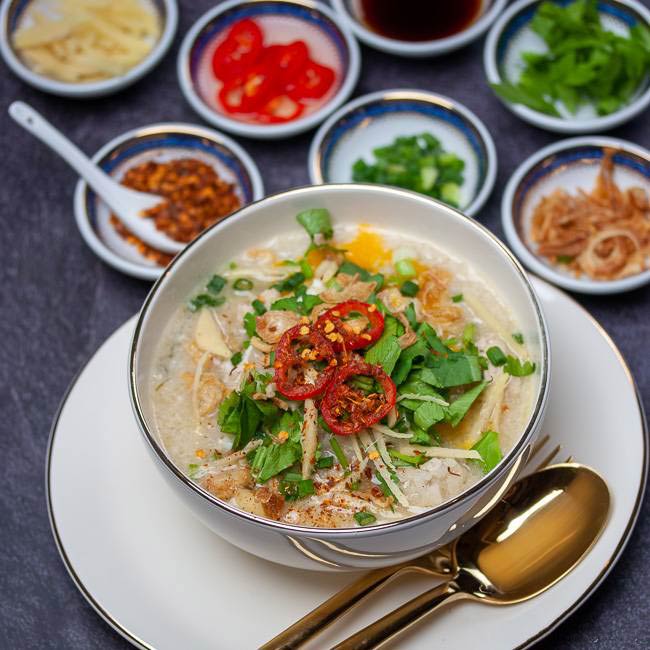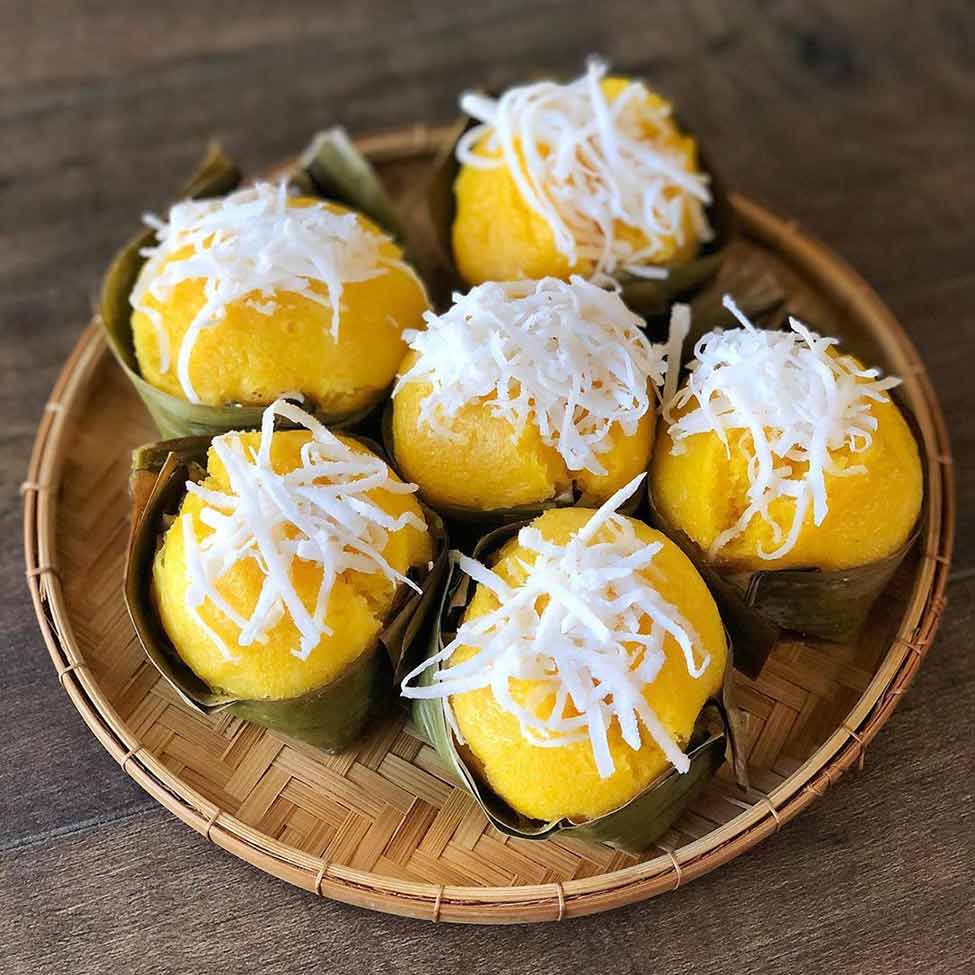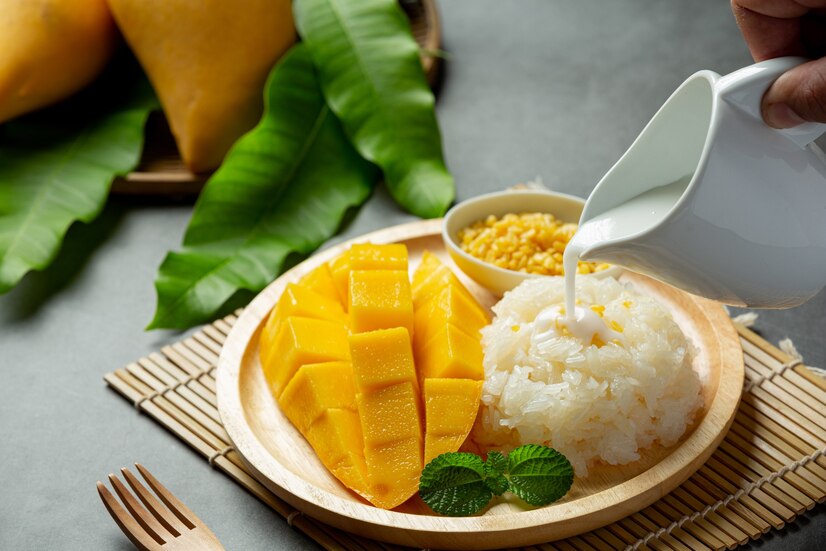Chiang Mai is a culinary paradise, blending the flavours of Thai, Burmese, and Chinese influences into mouthwatering dishes. The city’s food scene is a sensory delight, with an array of delicious options to try. Indulge in some of the top dishes like khao soi, a delectable coconut curry soup topped with crispy noodles, or sai oua, a fragrant pork sausage bursting with lemongrass and other aromatic ingredients. Exploring Chiang Mai’s bustling street food scene is an adventure in itself, with vibrant night markets and charming food carts lining the streets. As you meander through the city, be captivated by the enticing scents of sizzling meats, steaming noodles, and simmering curries wafting through the air. And don’t forget to quench your thirst with a refreshing glass of cha yen, Thailand’s beloved iced tea. Embark on a culinary journey through Chiang Mai’s diverse cuisine for an unforgettable dining experience that will leave you craving more.
Khao Soi
Khao soi is a vibrant culinary masterpiece from northern Thailand, rich with history and flavour. This dish marries creamy coconut broth with spicy undertones, enveloping tender braised chicken atop a nest of egg noodles. A crown of crispy fried noodles, tangy pickled mustard greens, zesty lime, and sharp shallots adds an irresistible crunch and zest that transforms each bite into an unforgettable experience.
The origins of khao soi remain a mystery, but its status as a northern Thai staple is undeniable. Each vendor crafts their unique version, swapping chicken for beef or pork and experimenting with spices to delight local palates. Despite these variations, every bowl emerges as an artistic masterpiece—creamy textures and bold flavours that captivate your taste buds and leave you craving more.
Ready to explore khao soi? Head to Chiang Mai’s lively street stalls and food markets, where the sizzle of hot oil fills the air with mouthwatering aromas. Each vendor offers a distinct version, crafted with passion. Savour crispy noodles mingling with tangy pickled mustard greens and a splash of lime that complements the spicy broth’s heat. It’s a flavour explosion you can’t afford to miss!
Khao soi is a necessity for anyone looking for a new culinary adventure in Chiang Mai. And who knows, you might just discover your new favourite Thai dish.
Sai Oua
Bite into sai oua, and you’ll immediately savour the juicy tenderness of the pork. Yet, it’s the bold fusion of chilli paste, galangal, lemongrass, and kaffir lime leaves that truly elevates this sausage. These spices dance together to leave a lasting impression on your palate long after you’ve finished eating.
But sai oua is more than just a delicious sausage. It’s a versatile ingredient that can be used in a variety of dishes. For a traditional meal, pair it with sticky rice, fresh herbs, and a spicy chilli dip that takes the heat to the next level. And don’t be afraid to get creative: sai oua can be incorporated into salads, stir-fries, and other dishes to add a burst of flavour.
As you wander through northern Thailand, don’t miss the chance to grab sai oua from a vibrant market or street stall. Let the lively atmosphere envelop you as you savour this spicy sausage. Sai oua isn’t merely tasty; it’s a cultural emblem, showcasing the region’s rich tapestry of Thai, Burmese, and Lao influences, a true testament to local culinary creativity.
Larb Mote Daeng
Looking for a dish that’s sure to pack a punch? Larb mote daeng is a northern Thai delicacy that’s not for the faint of heart. Made with succulent grilled beef, spicy chilli paste, tangy lime juice, and savoury fish sauce, this dish is a flavourful explosion in every bite.
One of the most unique aspects of this dish is the use of army ant eggs as a topping. These small red ant eggs add a distinctive flavour and texture, making it truly one-of-a-kind.
It’s not just the ingredients that make larb mote daeng unforgettable. This dish, a staple of northern Thai cuisine, pulses with cultural significance. Celebrated at festivals and cherished by locals, it’s more than a meal; it’s a tradition on every plate.
When you take a bite of larb mote daeng, the bold flavours of the beef and chilli paste will immediately hit you. The tangy lime juice and savoury fish sauce balance out the spiciness, while the crispy fried rice adds a satisfying crunch.
Overall, larb mote daeng is excellent for anyone looking to experience the unique flavours of northern Thai cuisine. So grab some sticky rice and prepare your taste buds for an adventure!
Kaeng Hang Le
Northern Thailand’s cuisine is a vibrant fusion of flavours, deeply influenced by its neighbours, Laos and Myanmar. At the heart of this culinary wonder is kaeng hang le, a slow-cooked pork belly curry that captivates with its rich, hearty taste and aromatic spices.
They craft this dish by simmering succulent pork belly in a fragrant medley of ginger, garlic, and chilli paste. As the pork tenderises, these spices weave through each bite, creating a melt-in-your-mouth sensation. The kitchen fills with an irresistible aroma, a tantalising blend of ginger and spices that captivates your senses.
The colours of the dish are equally striking, with the deep-red hue of the curry contrasting beautifully with the fresh green herbs and aromatic spices. The addition of fresh herbs such as Thai basil or cilantro adds a burst of freshness that complements the rich, earthy flavours of the curry.
In northern Thailand, locals have their own unique variations of kaeng hang le. For instance, some regions prefer to use different types of chillies or add extra ingredients such as tamarind or palm sugar to create a more nuanced flavour profile. These variations are a testament to the region’s culinary traditions and the creativity of the local people.
Kaeng hang le is more than just a delicious dish; it’s a cultural treasure of northern Thailand. Passed down through generations, each family infuses its own unique flair into the recipe. This savoury delight graces tables at weddings and festivals, embodying the heart and soul of the region’s culinary heritage.
Nam Prik Noom
Nam prik noom is a popular dish in Chiang Mai well worth trying. Made from roasted green chillies, garlic, and shallots, it’s a flavourful and spicy dip that’s perfect for adventurous eaters.
To truly savour nam prik noom, you must experience the symphony of flavours it offers. Roasted green chillies bring a sweet smokiness, while garlic and shallots add rich depth. Together, they form a tantalizingly spicy dip that elevates any dish it accompanies.
One of the best things about nam prik noom is how easy it is to enjoy. Simply scoop it up with some grilled meat or steamed vegetables, and you’re good to go. It’s the perfect way to add spice to your meal and experience the bold flavours of northern Thai cuisine.
In Chiang Mai, the aroma of freshly roasted chillies fills the air at markets and street stalls. Seek out those vendors who char their chillies over open flames for a rich, smoky kick. Dare to mix and match; nam prik noom pairs wonderfully with everything from sticky rice to crunchy pork rinds, offering a burst of flavour in every bite.
If you’re looking to experience the unique flavours and culinary traditions of northern Thailand, nam prik noom is a great place to start.
Kanom Jeen Nam Ngiaw
In northern Thailand, kanom jeen nam ngiaw reigns supreme as the ultimate comfort food. The dish features soft, chewy fermented rice noodles swimming in a spicy pork broth that tantalises the taste buds. But it’s the tender braised pork—slow-cooked to perfection and shredded over the noodles—that truly elevates this culinary masterpiece with its rich, savoury depth.
The pork is just the beginning. Tangy pickled greens and fresh herbs slice through the broth’s richness with zest. Hours of simmering pork bones unleash deep flavours, while a fiery blend of chilli paste, garlic, and ginger electrifies every spoonful.
As you wander through northern Thailand, seize the opportunity to indulge in kanom jeen nam ngiaw. Head to Ban Rong Ha, where a modest family-run spot has mastered this dish over generations. The surroundings may be unassuming, but the flavours are nothing short of extraordinary and will have you yearning for more.
Kao Tom
As you savour your first spoonful of kao tom, the rich scent of ginger and coconut milk envelops you. This timeless northern Thai dish combines sweet and savoury in a comforting sticky rice soup, perfect for any meal, any time.
They make the rich, creamy broth with coconut milk, adding a touch of sweetness that complements the savoury meat perfectly. The addition of ginger gives the soup a slight kick that balances the sweetness and adds depth to the flavour. Whether made with chicken or pork, kao tom is a warming and satisfying meal.
Kao tom, a beloved staple of northern Thai cuisine, warms hearts and bellies during the cooler months. This comforting dish is more than just a meal; it’s a symbol of community and togetherness, bringing families and friends closer with every shared bowl.
Explore the rich culinary tapestry of northern Thailand with kao tom, a dish that embodies the soul of the region. Relish in its comforting warmth and let your taste buds dance to the vibrant flavours of authentic Thai cuisine.
Khanom Tan
Are you a fan of sweet treats? If so, you have to try khanom tan, a delectable dessert from northern Thailand. Made with glutinous rice flour, this sweet and chewy confection has a texture similar to mochi, making it a unique and satisfying dessert.
Crafting khanom tan is a flavourful art. It begins with shaping tiny, tender spheres from glutinous rice flour and water, steamed to soft perfection. These delicate orbs are then filled with a luscious mix of mung or red beans, sugar, and coconut milk for an explosion of creamy sweetness. Wrapped around this rich filling, they undergo another steaming session to achieve their irresistible charm.
Savour the irresistible allure of khanom tan, a beloved dessert that captivates with every bite. Warm and inviting, it’s drenched in rich coconut cream and luscious palm sugar syrup, perfectly balancing its chewy texture with creamy sweetness.
Khanom tan is not just a dessert; it’s a cultural icon of northern Thai cuisine. It’s easy to find in street stalls and traditional markets throughout the region. And its affordable price makes it a popular mid-afternoon snack or dessert after a spicy meal.
The origins of khanom tan remain a mystery, but many suggest it was brought to northern Thailand by the Tai Yuan people from China. This delightful dessert, once reserved for weddings and special events, quickly captured local hearts and became a beloved treat.
Mango Sticky Rice
Treat yourself to the irresistible delight of Thailand’s mango sticky rice. This iconic dessert captivates with its perfect marriage of sweet, glutinous rice and vibrant, juicy mango slices that explode with flavour. Infused with creamy coconut milk and sugar, each bite offers a sublime taste experience that beautifully complements the tropical fruit.
Mango sticky rice offers more than just a delightful taste; it’s a cultural emblem of Thailand, rich in tradition and history. This refreshing dessert brightens sweltering summer days and doubles as an invigorating breakfast that awakens the senses.
What’s more, mango sticky rice is incredibly easy to make at home. So, you can bring a taste of Thailand into your kitchen with ease. But don’t be fooled by its simplicity – this dish packs a punch of authentic Thai flavour.
So go ahead, indulge in this beloved delicacy and discover the magic of Thailand’s desserts.
Kao Tom Mut
Indulge in the captivating blend of sweet and savoury with kao tom mut, a northern Thai dessert that enchants your senses. Picture sticky glutinous rice wrapped around ripe bananas, simmered to perfection in rich coconut milk and palm sugar. Each bite is a flavour symphony: tender rice clings lovingly, banana’s sweetness shines through, while nutty coconut richness dances on your palate.
Discover the cultural significance of kao tom mut in northern Thai cuisine and explore the many markets and street vendors where you can find it. Take a journey through the streets of Chiang Mai, and you’ll find vendors selling this dessert on the sides of the road, at the night markets, or in local shops.
Conclusion
Chiang Mai’s dining scene is a culinary adventure waiting to happen. From sizzling street vendors to cosy family-run eateries and elegant upscale restaurants, the city caters to every taste. Yet, it’s the northern Thai cuisine that truly captivates—bursting with bold, intricate flavours that promise an unforgettable journey for your taste buds.
Picture yourself strolling through vibrant night markets, the air thick with tantalising aromas of grilled meats and fiery curries. Envision sitting at a cosy eatery, mesmerised as a skilled chef crafts your meal over an open flame. In Chiang Mai, dining transcends mere sustenance; it’s an unforgettable adventure for the senses.
The food? It’s an adventure for your taste buds. Imagine the tangy kick of khanom jeen, those fermented rice noodles, paired with the fiery zest of sai oua, a spicy pork sausage. Each bite is a harmonious dance of sweet, sour, salty, and spicy flavours that will leave you craving more.
Northern Thai cuisine offers more than just flavours; it’s a vibrant cultural tapestry woven with rituals and traditions. In Chiang Mai, dining transforms into an immersive experience, where communal meals and the aromatic embrace of medicinal herbs and spices invite you to savour every moment.
So, whether you’re a seasoned foodie or just looking for a new culinary adventure, Chiang Mai should be at the top of your list. Don’t miss the chance to sample the flavours that make this region truly unforgettable.

